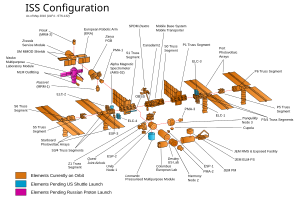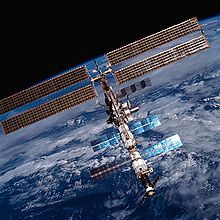
The ISS serves as a research laboratory that has a microgravity environment in which crews conduct experiments in biology, human biology, physics, astronomy and meteorology.[11][12][13] The station has a unique environment for the testing of the spacecraft systems that will be required for missions to the Moon and Mars.[14]
| Configuration | ||
|---|---|---|
 | ||
| Station elements as of 18 May 2010[update] |
The ISS is operated by Expedition crews, with the station programme maintaining an uninterrupted human presence in space since the launch of Expedition 1 on 31 October 2000, a total of 9 years and 227 days. The programme is thus approaching the current record, set aboard Mir, of 3,644 days (8 days short of 10 years), with the ISS expected to take the record on 23 October 2010.[15] As of 17 March 2010[update], the crew of Expedition 23 is aboard.[16]
The station is maintained at an orbit between 278 km (173 mi) and 460 km (286 mi) altitude, and travels at an average speed of 27,724 km/h (17,227 mph), completing 15.7 orbits per day.[21]
Land speed record
1963 – present (jet and rocket propulsion)
| October 15, 1997 | Black Rock Desert, USA | ThrustSSC | Turbofan | 1223.657 km/h | First supersonic record |
.
.
Video Capture Of The ISS From Earth
.
Video Capture Of Earth From The ISS In Space
.

The interactions between the components of the ISS Environmental Control and Life Support System (ECLSS)
 .
.
.
.
.
.
.

.
.
.
.
.











No comments:
Post a Comment